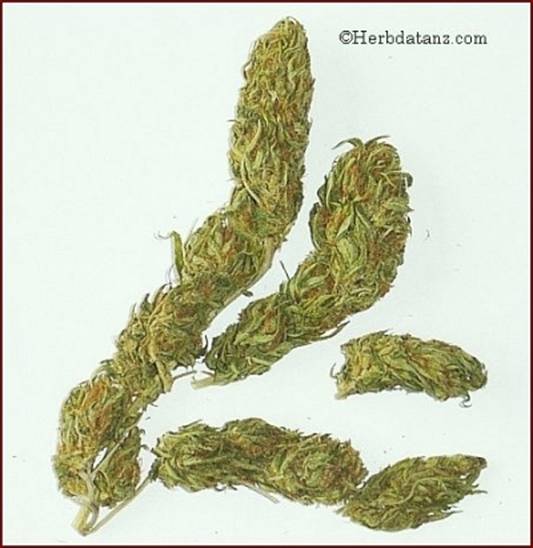
 Cannabis sativa. L
Cannabis sativa. L
Denston�s Pharmacognosy.
Compiled and Edited by Ivor Hughes.
INDIAN HEMP
Synonym:
Cannabis Indica; Cannabis.Botanical Source:
The dried flowering or fruiting tops of the pistillate plant of Cannabis saliva Linn.Fam.:
Cannabinacece.Plant Habit:
An annual dioecious herb with palmately-divided hairy leaves. The pistillate inflorescence is repeatedly branching, and resembles that of the Hop except that the central axis is not suppressed but grows out into a leafy shoot.Cultivation:
Non-narcotic Products.Hemp. When the plant is in a high state of cultivation on rich soil in a temperate climate, an abundance of strong pericyclic fibers develops in the stems. These fibers, after separation and treatment, constitute hemp. The plant thus cultivated has no narcotic properties.
Hempseed. Under similar conditions the pistillate plants produce numerous small fruits which yield on expression Hempseed Oil.
Narcotic Products:
When grown on the plains of tropical India abundant resinous secretion is produced in glandular hairs, especially numerous on the pistillate flowering tops. The pericyclic fibers of the stems are poorly developed.The method of cultivation is as follows;
 Collection
and Preparation
Collection
and Preparation
The stems of the plant are out about 15 cm. above the ground, exposed to the sun for a few hours, cut into 30 cm. lengths, and the flower-free portions removed. The remainder is stamped or trodden flat to press the resin among the flowers. At intervals the mass is beaten to remove leaves, fresh twigs are added, and the treading continued. As a result of this treatment the resin and flowers become consolidated into flat patches at the apex of the twigs.
Round Ganja. In general the process is similar to that outlined above, but more care is exercised, and a more valuable product obtained. A larger proportion of stem and leaf is removed, and the natives, instead of tramping on the mass, roll it twig by twig in order to force the resinous matter into thin cylindrical pieces. Excess of stem and leaf is removed by hand.
Charas. This is an inferior product and consists of the resinous secretion crudely separated from vegetable matter. In some parts of India it is collected by beating the flowering tops in coarse cotton cloths spread on the ground. A greenish-brown soft mass adheres, and may be purified by pressing it through the cloths. In other districts men traverse the plantations at flowering time, wearing leather aprons on which the resin adheres�this being subsequently scraped off.
Bhang. This consists of the carefully-dried lower leaves and shoots removed from cultivated male or female plants in the early stages, or from wild plants. It is unfit for medicinal use owing to deficiency of resin, and is used for the preparation of haschisch, or majun, a narcotic electuary.
Geographical Source:
Constituents:
Resin, termed cannabinone, a soft brown mixture constituting the bulk of the alcoholic extractive. It appears to contain the most important constituents of the drug, which are probably; Cannabinol, C21H26O2, a toxic phenolic substance
1 obtained as pale-yellow, viscous oil by distillation in vacuo. It has been suggested2 that this substance is the precursor of the true active narcotic principle, the phenol being broken down in the body to some other derivative with more intense physiological activity.Cannabol and Cannabidiol, the former isomeric with the latter which appears to be present in traces in drug of Indian origin but is definitely found in Egyptian and American Hemps.
These substances readily decompose to resinous bodies on exposure to the air or by the oxydase present in the drug. Indian hemp should therefore be stored in a dry condition in airtight containers, and preferably used before one year old. Choline and a trace of volatile oil are also present.
There is no generally-accepted chemical method of assay and the resin content is no criterion of activity. It has been claimed
3 that the optical rotation of a solution of the resin in carbon tetrachloride is proportional to the physiological action, as tested by its effects on experienced Indian hemp smokers.This claim has been contested and an alternative test proposed
4 in which the active principles of the resin are extracted with 0-5 per cent aqueous caustic soda from a carbon tetrachloride solution. The alkali extractive is then coupled with diazotized p-nitroaniline to produce a water-insoluble dye which is separated, dissolved in alcohol, estimated colorimetrically and the result expressed in terms of potency of the drug. Biological methods of assay, e.g. by oral administration to cats, have also been used.Standards
1. Limit of fruits, large foliage leaves and stems over 3 mm. in diameter�10 per cent.
2. Limit of foreign organic matter�2 per cent.
3. Alcoholic extractive, by the prescribed method, not less than 10 per cent.
4. Limit of acid-insoluble ash�5 per cent. The constitution is discussed by Cahn, J'. Chem. Soc. Land., 1932, 1342; 1933, 1400 et seq.
2. Bose and Mukerji, Nature, Land., 1943, 152, 109.
3. Bhose and Bhattacharjee, Analyst, 1935, 60, 313.
4. Mukhopadhyay, Subramanian and Dunnicliff, Analyst, 1943, 68, 70.